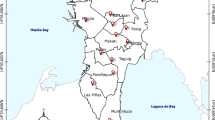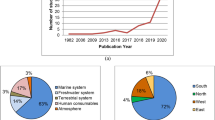Abstract
Human exposure to particulate matter was determined in the urban environment of Delhi. Monitoring was done on an 8 h exposure basis. Samples were collected using an eight stages impactor (Marple Cascade Impactor) at five sites during December 2010 to March 2011. Fifteen samples were collected and each stage samples were analyzed gravimetrically and chemically (for metals). The maximum (2,118.45 μg/m3) exposure due to particulate matter (PM) was at Okhala, an industrial site and the minimum (490.17 μg/m3) in Jawaharlal Nehru University an educational Institute. Exposure due to metals (viz. Cu, Cd, Mn, Pb, Ni, Co) at the five locations was mostly dominated by Pb, Mn, Ni and least dominated by Cd,Cu and Co. Okhala was most polluted area and Jawaharlal Nehru University (forest area, out of industrial and commercial hub) the least. Pb, Ni, Co were dominant metal aerosols of Okhala, while Kaushambi, being fully residential area but located near waste site and national highway, was rich in Pb, Mn and Ni. Pb concentration exceeded government guideline.





Similar content being viewed by others
References
Srivastava A, Jain VK (2003) Relationship between indoor and outdoor air quality in Delhi. Ind Build Environ Monit Asset 29:75–88
MoST (2000) Handbook on transport statistics in India: (1999). Transport Research Wing, Ministry of Surface Transport, New Delhi
The Indian Society of Environmental Science and Technology (ISEST) (2000) Seminar in Hyderabad, at the prestigious Indian Institute of Chemical Technology. ISEST, Mumbai, 18–20 September 2000
Ministry of Environment and Forests (2000b) Personal communication. Ministry of Environment and Forests (MoEF), New Delhi
World Urbanization Prospects (2009) The revision population data base. UN Department of Economic and Social Affairs, New York
Government of India (2000) White paper on pollution in Delhi with an action plan. Ministry of Environment and Forest, New Delhi
Pope CA, Burnet RT, Thun MJ, Calle EE, Krewski D, Ito K, Thurston GD (2002) Lung cancer cardiopulmonary mortality and long term exposure to fine particulate air pollution. J Am Med Assoc 287(9):1132–1141
Brook RB, Franklin B, Wayne C, Yuling H, George H, Michael L, Russell L, Murray M, Jonathan S, Sidney C (2004) Air pollution and cardiovascular disease: a statement for healthcare professionals from the expert panel on population and prevention science of the American heart association. ISSN: 0009-7322. Online ISSN: 1524-4539. American Heart Association, New York
Sarma AALN, Srinivas S, Karthikeya A (2005) Studies on aberrations in climate impacts water balance model. J Ind Geophys Union 9(3):209–218
Kant M (1977) Method of air sampling and analysis, 2nd edn. APHA, Washington, DC
National Academy of Sciences (NAS) (1983) Risk assessment in the federal government: managing the process. National Academy Press, Washington, DC
National Academy of Sciences (NAS) (2001) Research priorities for airborne particulate matter III. Early research progress. National Academy Press, Washington, DC
Levy JI, Hammitt JK, Yanagisawa Y, Spenger JD (1999) Development of a new damage function model for power plants: methodology and application. Environ Sci Technol 33:4364–4372
Schwartz J, Ballester F, Saez M, Perez-Hoyos S, Bellido J, Cambra K, Arribas F, Canada A, Perez-Boillos MJ, Sunyer J (2001) The concentration-relation between air pollution and daily deaths. Environ Health Prospect 109:1001–1006
US-EPA (1998) Methodology for assessing health risks associated with multiple US-EPA. Pathways of exposure to combustor emission. EPA-600/R-98-137. National Center for Environmental Assessment, Cincinnati
US-EPA (1996) Risk assessment support to the development of technical standards for emissions from combustion units burning hazardous wastes. EPA 68-W3-0028. US-EPA, Research Triangle Park
Pope CA, Thum MJ, Namboodri MM, Dockery DW, Evans JS, Speizer FE, Health CW (1995) Particulat air pollution as a predictor of mortality in a prospective study of US adults. Am J Respir Crit Care Med 151:669–674
US EPA (1997) Exposure factor hand book. EPA/600/P-95/002. A,B,C Environmental Protection Agency, Office of Research and Development, Washington, DC
US EPA (2011) Exposure factor hand book. EPA/600/P-95/002. A,B, Environmental Protection Agency, office of Research and Development, Washington, DC
Chang J, Liu M, Li XH, Lin X, Wang L, Gao L (2009) Primary research on health risk assessment of heavy metals in road dust of Shanghai, China. Environ Sci 5(29):548–554
Desai HG, Zaveri MP (1972) Postgrad Med J 48:87–90
Lin M, Hen YC, Burnett RT, Villeneuve PJ, Rewski KD (2005) The influence of ambient coarse particulate matter on asthma hospitalization in children: case crossover and time-series analyses. Environ Health Perspect 11:575–581
Leung AOW, Duzgoren-aydin N, Cheung KC, Wong M (2008) Heavy metals concentration of surface dust from e-waste recycling and its human health implication in southern China. Environ Sci Technol 47(7):2674–2680
Biptista LF, Miguel ED (2005) Geochemistry and risk assessment of street dust in Luanda, Angola: a tropical urban environment. Atmos Environ 39(25):4501–4512
IARC (1990) Chromium, nickel and welding. Monograph on the evaluation of carcinogenic risk of chemicals to human 49:1–677
IARC (1993) Beryllium, cadmium, mercury, and exposure in the glass manufacturing industry. Monogr Eval Carcinog Risk Chem Human 58:1–444
Centre Pollution Control Board (2009) National ambient air quality standard. Ministry of Environment and Forest (MoEF), Government of India, New Delhi
Occupational Safety and Health Administration (OSHA) (2012) Regulations standards-29 CFR 1910 subpart-Z toxicants hazardous substance. http://www.osha.gov/pls/oshaweb/owastand.display_standard_group. Accessed 15 Oct 2012
Saksena S, Singh BP, Prasad RK, Prasad R, Malhotra P, Joshi, V, Patil PS (2004) Exposure of infants to outdoor and indoor air pollution in low-income urban area: a case study of Delhi. East–West working paper no. 54. J Expos Anal Environ Epidemiol 14:14–25
Kulkarni MM, Patil RS (1999) Monitoring of daily integrated exposure of outdoor workers to respirable particulate matter in an urban region of India. Environ Monit Assess 56:129–146
Srivastava A, Jain VK (2007) Size distribution and sources identification of total suspended particulate matter and associated heavy metals in the urban atmosphere of Delhi. Chemosphere 68:579–589
Srivastava A, Jain VK (2007) Seasonal trend in coarse and fine particle sources in Delhi by the chemical mass balance receptor model. J Hazard Mater 114(1–2):283–291
Schuhmacher M (2004) Pollutants emitted by a cement plant: health risks for the population living in the neighborhood. Environ Res 95:198–206
EPA (2011) Cancer risk guideline http://www.epa.gov/cancerguidelines. Accessed 2 May 2011
Smith RL (1996) Risk-based concentrations: prioritizing environmental problem using limited data. Toxicology 106:243–266
Acknowledgments
Author deeply acknowledged University Grant Commission (UGC), Government of India, for fellowship. Author also thankful to Mr. Rajesh Kumar and Miss Pooja Singh, for their help during work period.
Author information
Authors and Affiliations
Corresponding author
Rights and permissions
About this article
Cite this article
Kushwaha, R., Lal, H., Srivastava, A. et al. Human Exposure to Particulate Matter and Their Risk Assessment over Delhi, India. Natl. Acad. Sci. Lett. 35, 497–504 (2012). https://doi.org/10.1007/s40009-012-0085-z
Received:
Revised:
Accepted:
Published:
Issue Date:
DOI: https://doi.org/10.1007/s40009-012-0085-z




